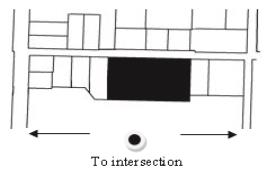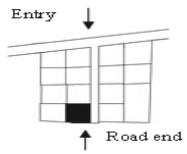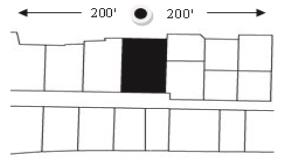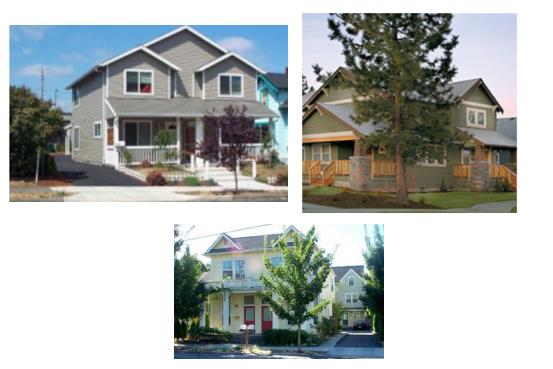Chapter 18.25
INFILL RESIDENTIAL DEVELOPMENT STANDARDS
Sections:
18.25.030 Infill residential design standards.
18.25.040 Multifamily dwelling, small scale infill in DMU I and DMU II zones.
18.25.050 Review and decision.
18.25.010 Purpose.
Within the R4-8, DMU I, and DMU II districts, the opportunity to achieve maximum utilization exists on parcels one and one-half acres or less in size that have been bypassed in past platting. Alternative development standards are deemed an appropriate incentive to accomplish infilling within established residential neighborhoods. The primary purpose of infill incentives is to encourage development in existing but underutilized lots located within established neighborhoods in a way that is consistent with the existing neighborhood character. (Ord. 2021-015 § 1 (Exh. A))
18.25.020 Criteria.
Within the R4-8, DMU I, and DMU II districts, parcels that meet all the following criteria are eligible for infill:
A. The infill provisions of this chapter can be accomplished through the design review process or short subdivision permit process (SMC Title 17).
B. All public services and facilities are immediately available and adequate to the site or can be made available and adequate prior to completion of development.
C. The public roads and streets serving the site are adequate to carry the additional traffic generated by the development of the site.
D. Lot Requirements. The following minimum lot requirements are met:
1. Lot Area. Minimum and maximum lot sizes, lot width and depth, and setbacks are based on calculating the average of the lots along the block face as described in SMC 18.25.030(A). (Ord. 2021-015 § 1 (Exh. A))
18.25.030 Infill residential design standards.
Property that is eligible for infill residential development and is proposed to be located within an established neighborhood will adhere to site and architectural design requirements. While variation in architectural design is desired, the purpose of these requirements is to ensure compatibility of new infill development with the character of the existing neighborhood.
A. New infill residences must meet the following site and architectural design criteria, as defined by the predominant design characteristics of the existing buildings along both sides of the public or private right-of-way or easement on which the infill development fronts (the “block face”). The block face is measured from intersection to intersection, to the road end, or 200 feet in either direction from the building site, whichever is nearest.
Examples of how to measure the block face:
1. Measured from intersection to intersection – Block face is both sides of the street from intersection to intersection:
2. Measured to the road end – Block face is both sides of the street from road entry to road end:
3. Measured 200 feet in either direction from infill site: Block face is both sides of the street 200 feet in each direction from infill site:
B. Building Orientation. The orientation of new infill residences within an established neighborhood must match the predominant orientation of other buildings along the block face.
C. Front Yard Setback. The front yard setback of an infill residence within an established neighborhood must be the average of the existing residences along the block face.
D. Height.
1. If the infill residences proposed within an established neighborhood are five to nine feet taller than the average height of the existing residences on the block face, the infill residences must step back the upper floor(s) a minimum of five feet from the first floor facade to help maintain compatible scale.
2. When the proposed infill residence’s height is 10 feet or higher than the average height of the existing residences on the block face, the upper floor must step back a minimum of eight feet.
3. Stepbacks required above must be made on the building face in the following circumstances:
a. Street face; and
b. Side building face when adjacent to existing residences. New proposed infill residences adjacent to another new infill residence are not required to provide side stepback(s).
4. The director of the department of community development or designee may determine that the above required stepbacks do not provide sufficient compatibility of bulk and scale to existing residences on the block face. Upon such a finding, and when the proposed infill residences are 10 feet or higher than the average height of the existing residences on the block face, the director or designee may decrease the height of the infill residences.
E. Architectural Variety. Proposed infill residences within an established neighborhood must incorporate architectural variety to their front facade, ensuring housing style diversity. Duplicative front facade elevations adjacent to each other are prohibited. Simple reverse configurations of the same facade elevation on adjacent lots are not sufficient to meet this requirement. In order to ensure architectural variety, three or more design elements per infill residence must be utilized:
1. Different window opening locations and designs;
2. Different roof line configurations;
3. Different entry/porch designs;
4. Different exterior materials and finishes;
5. Different garage location, configuration, and design.
F. Narrative and Building Design. The applicant must provide a written narrative describing the predominant character of the existing residences’ block face; detailing how the proposed infill residences’ size, height, placement, and design meet the above design standards; and describing how compatibility along the predominant block face has been met. In addition, conceptual architectural building design must be submitted with the short subdivision and/or conditional use application where applicable. (Ord. 2021-015 § 1 (Exh. A))
18.25.040 Multifamily dwelling, small scale infill in DMU I and DMU II zones.
A. Multifamily development is limited to duplex, triplex, or fourplex dwellings located on a single parcel/lot not smaller than 9,000 square feet for a duplex (9.7 density), 10,500 for a triplex (12.4 density), and 12,000 square feet for fourplex units (14.5 density).1 Multiplex structures will be designed to create the appearance, especially on corner lots, of single-family dwelling units through use of height limits, entryway grouping, multi-pitched rooflines, and street side window openings (See Figure 1 below).
B. Building lot coverage for multifamily structures cannot exceed 50 percent.
C. The development of multifamily housing under these standards is not subject to the floor area ratio (FAR)2 included in SMC 18.57.030 and 18.57.040, Development bonuses.
Figure 1
(Ord. 2021-015 § 1 (Exh. A))
18.25.050 Review and decision.
The director of the department of community development or designee will review submitted building permit applications for compliance with this chapter, approved conceptual building drawings, and any applicable conditions of approval and make the decision to grant or deny the permit. (Ord. 2021-015 § 1 (Exh. A))
Both DMU zones do not currently have density limitations.
Using FAR would allow more developable area that would be acceptable. For example, with a FAR of one which is included in SMC 18.57.030 the 9,000 square foot lot would be able to have 9,000 square feet of development on it. Using lot coverage of 50 percent reduces that allowed developable square footage to 4,500 square feet.


